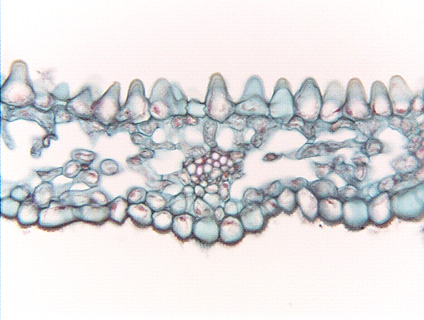Up
Ordinary epidermis
Guard cells
Thick cuticle
Thicker cuticle
Thin cuticle
Parasitic plant
Petal epidermis
Sclerified epidermis
Papillose epidermis
Sculptured cuticle
Elaborate cuticle
Cuticular horns
Radial walls
Cuticle proper
No epidermis
Epidermal peels
Cycad peel
Paradermal
Typical stoma
Sunken stoma
Stomatal orientation 1
Unusual orientation 2
Artifact
Stomata and fibers
Stomatal crypts
Crypts, mag.
Crypt margin
Non-crypt
Water lily
Stomatal channels
Groove, hi mag
Subsidiary cells
Ledges
Papillae
Trichome
Uniseriate hair
Peltate hair, mag
Peltate, lo mag
Branched hairs
Trichome base
Lithocyst, Ficus
Lithocysts, hemp
Bulliform cells
Grass epidermis
Multiple epi
Uniseriate?
Peperomia
| |
 Fig.
10.4-1. Transverse section of milkweed petal (Asclepias
tuberosa). Compare the upper and lower epidermises of this petal – the
epidermis cells on the lower side have a rather ordinary shape, but those
on the upper side each bulge outward as a large papilla. You can see
that the papilla is formed as the outer wall and the protoplast bulge outward;
this same surface texture could also be created by having a round protoplast
with a thickened wall or an ordinary protoplast and wall with a thickened
cuticle. Papillose epidermis cells are quite common on petals, giving them a
velvety appearance. Fig.
10.4-1. Transverse section of milkweed petal (Asclepias
tuberosa). Compare the upper and lower epidermises of this petal – the
epidermis cells on the lower side have a rather ordinary shape, but those
on the upper side each bulge outward as a large papilla. You can see
that the papilla is formed as the outer wall and the protoplast bulge outward;
this same surface texture could also be created by having a round protoplast
with a thickened wall or an ordinary protoplast and wall with a thickened
cuticle. Papillose epidermis cells are quite common on petals, giving them a
velvety appearance.
|
 Fig.
10.4-1. Transverse section of milkweed petal (Asclepias
tuberosa). Compare the upper and lower epidermises of this petal – the
epidermis cells on the lower side have a rather ordinary shape, but those
on the upper side each bulge outward as a large papilla. You can see
that the papilla is formed as the outer wall and the protoplast bulge outward;
this same surface texture could also be created by having a round protoplast
with a thickened wall or an ordinary protoplast and wall with a thickened
cuticle. Papillose epidermis cells are quite common on petals, giving them a
velvety appearance.
Fig.
10.4-1. Transverse section of milkweed petal (Asclepias
tuberosa). Compare the upper and lower epidermises of this petal – the
epidermis cells on the lower side have a rather ordinary shape, but those
on the upper side each bulge outward as a large papilla. You can see
that the papilla is formed as the outer wall and the protoplast bulge outward;
this same surface texture could also be created by having a round protoplast
with a thickened wall or an ordinary protoplast and wall with a thickened
cuticle. Papillose epidermis cells are quite common on petals, giving them a
velvety appearance.